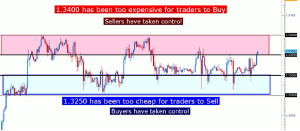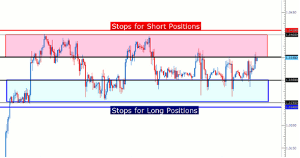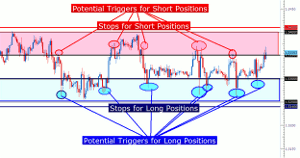One of the most beneficial, yet most neglected, market conditions by new traders is the range-bound market. James Stanley of DailyFX.com walks through how traders can look to take advantage of markets confined by support and resistance.
As traders, we almost can’t help ourselves….
Fast markets draw us in, almost as if there was a sign offering ‘free money’ to all those willing to take on the risk. It’s unfortunate, but in many cases—these are not the optimal market conditions for traders to be speculating in.
In the DailyFX traits of successful traders research, we found that the best time of the day to trade forex is the Asian session trading period; and the primary reason is because markets during this period of the day have a tendency to range.
The higher degree of respect for support and resistance, coupled with the generally slower moving prices proved to be much more amenable for traders than the fast and active markets commonly featured during the London or US sessions.
While ranges may not offer the same pulse-pounding potential to rack up hundreds or thousands of pips on a single trade, they are more than adequate for the pursuit of most traders’ goals. In this article, we’re going to look at the recent range put in EUR/USD, as well as how we can look to analyze and trade in such market environments.
The Technical Setup of the Range
Traders can use past market information to discern which prices have been seen as so cheap that traders rush in to buy, or prices so expensive that traders are compelled to sell.
This is the true establishment of a range: Prices are bound by an upper and lower area of prices that greatly change the order flow of that given asset. The chart below will illustrate further using the hourly EUR/USD setup:
EUR/USD has shown a strong range between 1.3250 and 1.3400

Created with Marketscope/Trading Station II
Click
to Enlarge
Since entering this range on January 10, the pair has seen strong support in the blue zone between 1.3250 and 1.3300, while resistance has come in the red zone of 1.3350 to 1.3400. Another way of looking at this range is that from 1.3350 to 1.3400, buyers have stopped buying as price was perceived as being expensive.
As buyers stop buying, a higher proportion of trades in the pair were sell orders.
These sell orders created supply in the market for EUR/USD, and price accordingly moved lower. The same can be said about the zone from 1.3250 to 1.3300. As prices have moved into this area in the recent past, buyers have increased their buying activity to outnumber sellers. This is increasing demand, and with increasing demand prices will rise. Another way of looking at a range is using support and resistance to trade supply and demand:
Support and Resistance as Supply and Demand

Created with Marketscope/Trading Station II
Click
to Enlarge
How to Trade the Range
Now that we know the zone where buyers and sellers have come into the picture with more prominence, we can begin to plan our approach for the range.
But before we get to triggering trades, we have to look at the potential risk-reward of any such entries.
Traders taking long entries can look below the bottom of the support zone at 1.3250 for stop placement. That way, if a price lower below 1.3250 comes in, which may be a sign of further lows that may print in the pair—the trader looking to play the range can look to exit before the breakout against them begins to put a dent into their equity.
And traders placing short entry orders can look to the upper portion of the resistance zone at 1.3400, so that any top-side breakouts in the pair can close the trader’s short position before significant damage may come about from an extended move.
Support and Resistance Provide Exit Levels Should the Range Turn into a Breakout

Created with Marketscope/Trading Station II
Click
to Enlarge
Entering Trades
Now that traders know how to setup the trade, they can start investigating the entry into the position. Since there isn’t a great distance between the upper boundary of the support zone, and the lower boundary of the resistance zone—traders need to be prudent into their range entries; as potential upside can be limited if the range continues.
So traders would only want to buy when price was in the blue zone between 1.3250 and 1.3300, or sell in the red zone between 1.3350 and 1.3400.
Traders looking to trigger into positions can investigate each candle as it closes on the hourly or four-hour chart (hourly shown above), to look for price swings in the market. Elongated wicks highlight price reversals that took place while that particular candle was forming.
Elongated wicks to the down-side of candles within the blue zone can be looked at as potential triggers into long positions; while elongated wicks in the red zone can be looked at as potential swing-highs for traders to sell. The chart above will illustrate in more detail:
By James Stanley, Trading Instructor, DailyFX.com











